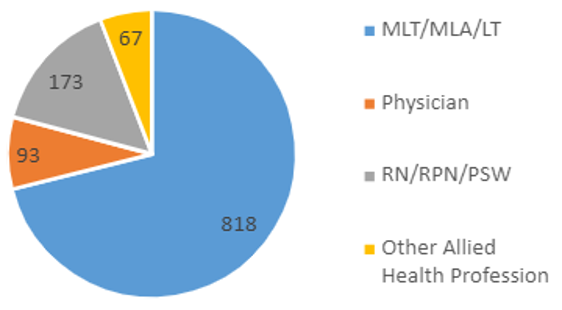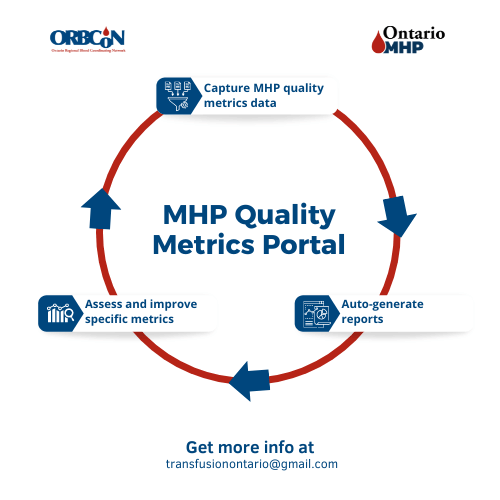June 2024

- Lessons Learned from a Multi-Code Event
- Code Grey – Cyber Attack – Lessons Learned – You Can Survive!
- Highlighting the 19th Annual ORBCoN/ CBS Transfusion Medicine Educational Symposium and Workshop
- Featured Resources
- MHP Quality Metrics Portal
- Upcoming Events
- Transfusionists Talks
- GHEST 2024 Save the Date
- U of T Rounds
Lessons Learned from a Multi-Code Event
Deborah Flowers, MLT, Charge Technologist Transfusion Medicine, EORLA
Most medical laboratory professionals are accustomed to the constant codes that sound overhead. On October 27, 2023, the Ottawa Hospital General Campus called an unprecedented Code Red, Code Orange and Code Grey, all within a few hours. Our team worked extremely well together under stress and solved emerging problems quickly, but could things have gone better? More importantly, what did we learn from our missteps?
Shortly before 4 pm, a Code Red was announced, and we were on emergency power. Not a cause for concern since critical areas like Transfusion Medicine are equipped with UPSs and an abundance of emergency plugs. Moments later, the lights flickered oddly, and a strange smell overtook the laboratory. In the days preceding, we had experienced several codes however this was different; it felt different. Someone suggested we prepare for evacuation, so we packed products into our Code Orange boxes and transferred the calls to the portable phone. When the notice came, we were ready. We grabbed our blood boxes, walked down the stairs, and set up in the Emergency Department garage. It wasn’t ideal but we were functional. We took inventory of the items we were missing, a charger for the portable phone, our external phone list, a pen. Small items that would have made our situation easier. Our first product request was for platelets which we hadn’t even thought to bring with us.
The Code Orange was next. Many of us have been involved in External Code Orange scenarios however never an internal disaster. It was surreal to see the Emergency Department deserted except for Emergency Response Personnel. Ambulances were diverted, patients were evacuated, transferred and discharged. We had already initiated our Code Orange policy, making it work for an internal disaster, so we continued.
Then a Code Grey was called, and we learned that emergency power had been lost to some parts of the hospital. No one could have imagined we would need a back-up for the back-up system. The next day when it was safe to return to the laboratory, it was an eerie scene. The smell was overpowering, and soot covered everything. The disaster cleanup would eventually take months to complete but we were back in Transfusion Medicine 24 hours after the first alarm sounded.
I don’t suggest laboratories plan to relocate as we did. In our situation, it was safe to bring blood products with us; we had time before the evacuation came. What was the most important lesson we learned? Effective communication is crucial in an infrastructure failure. In the beginning, our information was collected around a dying cell phone listening to situational updates. My advice to all medical laboratory professionals – review your contingency plan and recognize that communication is crucial. As Arthur Conan Doyle said, “It is easy to be wise after the event.”
Code Grey – Cyber Attack – Lessons Learned – You Can Survive!
Stephanie Thompson, MLT, BSC, MLS(ASCP)CM, Lead Technologist Hematology Department, WRH-Met Campus
Jessica Fortier, MLT, Lead Technologist Chemistry Department, WRH-Met Campus
Nicole Pilutti, MLT, Lead Technologist Transfusion Medicine Department, WRH-Met Campus
As we look back over the period in our lives from Oct 23, 2023 until Dec 13, 2023 our thoughts turn to the fact that we made it through. First some background. Windsor Regional Hospital – Metropolitan Campus was among the 5 southwestern Ontario hospitals to experience a cyber-attack in the middle of the night on a Sunday. On Monday morning, faced with no email, no Laboratory Information System, and no Hospital Information System, we served our patients to the best of our ability, often figuring new things out on the fly. This is a brief synopsis of how you can be prepared so you don’t have to figure it out on the fly. Lab is heavily reliant on automation and electronic systems in order to provide care to a high volume of patients, while ensuring quality and safety. How were we going to develop systems to be able to still provide the same level of quality care, safely?
- With no email available, a mass text program, RAVE, was set up for employees to sign up for. It gave occasional updates on what was going on behind the scenes, all the way to general communications.
- A large paper easel was set up for shift to shift communication and questions for management.
- Make sure your fax numbers are up to date for all the areas you service. Perhaps extra fax machines brought in. Lots of toner, paper and printer ink should be ordered.
- Addition of non-technical staff brought in to help with answering phones, faxing results and file finished reports.
- Addition of extra technologists and lab assistants is also a consideration.
- Explore the availability of printing directly from the instrument. Some of our instruments printed results with each sample run automatically, while others needed to be force printed for each patient.
- In our case, computers were available, just no network or LIS, however a spreadsheet was still functional for signing out blood products and entering daily QC. QC programs like Unity were still available to track QC. We have very robust downtime files on a USB stick, ready to go.
- Ensure updated abridged documents are available for critical values and criteria for extended or reflexive testing.
- A Backup of all SOP’s would come in handy, if possible, especially for results that require calculation.
- Developed barcode generation program utilizing existing barcode printers. Also, created stickers for reports indicating critical results phoned with time and, sample integrity (i.e., HIL indices)
- A process for manual filing (alphabetical or numerical) to ensure results can be retrieved if necessary.
- Developed Chemistry panels to streamline manual programming on analyzers and help reduce add-on testing.
- Have copies of catalogue numbers, suppliers, account numbers or billing codes for all the inventory you use, it makes ordering the things you need a lot easier.
- Some LIS transfusion medicine programs have a downtime viewer that records all the pertinent information on all patients that have been tested before. Be familiar with the process to download that information that is saved in the hard drive.
- Make sure your downtime requisitions are current, match the testing you do and are functional.
At the end of the day, all departments and their staff have to minimize these disruptions in order to provide quality, safe patient care.
Highlighting the 19th Annual ORBCoN/ CBS Transfusion Medicine Educational Symposium and Workshop
Valérie Rhéaume, North and East Ontario Regional Project Coordinator, ORBCoN
The Ontario Regional Blood Coordinating Network (ORBCoN) and Canadian Blood Services (CBS) co-hosted their annual Transfusion Medicine Educational Serology Workshop and Web Conference Symposium on April 10th and 11th this year. The primary objective of these annual educational events is to provide best practice information on blood transfusion to healthcare staff in community and rural hospitals across Ontario. Over the years, these events have become highly anticipated, drawing attendees across the province, nationally and internationally. Participants value the opportunity to access up-to-date information and learning they provide.
About the Workshop
The workshop titled Mysteries in a Test Tube, provided hands on practice and education to laboratory staff that work in hospital transfusion services. Participants chose from three tiers, each tailored to varying levels of complexity, ensuring a valuable learning experience for all levels of expertise. Each registered site received samples along with a case study containing tier-specific questions. Sites were given dedicated time to complete the work and submit their answers. These answers were then discussed collectively during the review session for each tier. A total of 38 attendees joined Dr. Johnathan Mack as he led engaging discussion sessions on April 10th, further enriching the workshop experience. The response was overwhelming, with all fifty workshop spots quickly filled, underscoring the demand for such interactive learning opportunities. For those that were unable to attend, the sessions are available for review on our website, extending the educational reach beyond physical attendance. 2024 CBS/ORBCoN Wet Workshop – Transfusion Ontario
About the Symposium
The symposium titled “The Blueprint for Massive Hemorrhage Protocol: Development, Implementation and Optimization in Rural Hospitals” drew an astounding 1151 registrations, attesting to its relevance and significance. Designed for healthcare workers in community and rural areas that are involved in blood component administration that may not have specialized knowledge in transfusion science, the symposium was accredited by the College of Physicians and Surgeons as well as the College of Family Physicians. The virtual format facilitated widespread participation, allowing hospital staff from across the province to benefit from the expert-led presentations.

The symposium program comprised three presentations, followed by a Q&A session with the presenters, which was moderated by Dr. Johnathan Mack. Dr. Laura Stone, representing Sault Area Hospital, delivered the first presentation titled “A Practical Approach to Updating the Massive Hemorrhage Protocol (MHP) at Your Community Hospital: What We Have Done and What We Have Learned,” focusing on their hospital’s experience in implementing a massive hemorrhage protocol. Dr. Andrew Petrosoniak’s presentation “Bringing your MHP to life: the roll out, the logistics and the training” centered on identifying strategies to ensure optimal implementation, utilization, and maintenance of MHPs. The final presentation, “Transfusion in the Pre-hospital and Inter-facility Transport System,” was delivered by Dr. Michael Peddle, covering the patient transport system in Ontario and a review of pre-transfer care to optimize patient outcomes prior to definitive care.
Feedback from attendees was overwhelmingly positive, with commendations for the informative content and collaborative spirit. Attendee’s were provided with a certificate of attendance after completing the event evaluation survey, and a draw was held for those that had completed the survey.

“In the years I have been in the Transfusion Medicine department, I have attended each TM Symposium. This one was the most informative and interesting.” – Anonymous
This year’s lucky winners were: Shannon Moores –100$ Amazon Gift Card, Grace Liu – 50$ Indigo Gift Card and Debbie Hamilton- 50$ Esso Gift Card.
If you missed the event, you can still view it by using the following link. 19th Annual TM Education Symposium – Transfusion Ontario
“This symposium was very helpful towards my understanding of the overall process of MHPs and how the products that are issued in the lab are used towards saving lives.” – Anonymous
We extend our heartfelt gratitude to all participants and eagerly anticipate seeing you at future ORBCoN/CBS events. Stay tuned to our events calendar for updates and announcements.
Featured Resources
MHP Quality Metrics Portal
Note: Each Ontario hospital will need to determine where the data for the metrics is housed within their facility and who will be responsible for gathering and entering the data.

Upcoming Events
Transfusionists Talk

GHEST 2024 Save the Date

U of T

June 20, 2024 @12pm-1pm
MLT Session – Interesting serology cases
Subscribe to U of T Transfusion Medicine Rounds mailing list to get registr